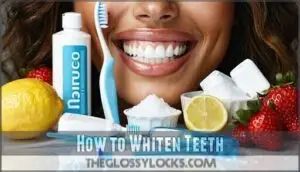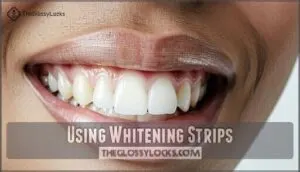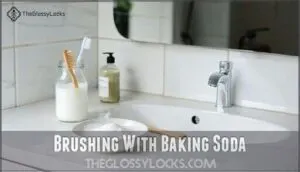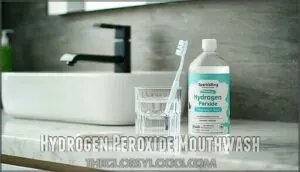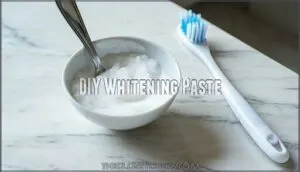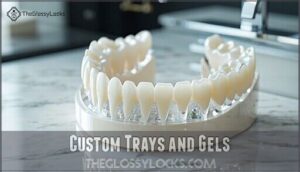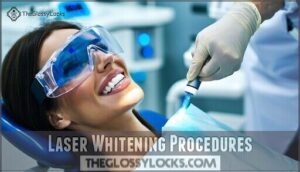This site is supported by our readers. We may earn a commission, at no cost to you, if you purchase through links.
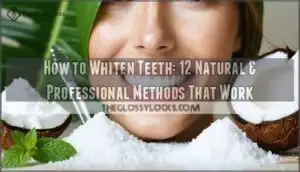
Natural methods like oil pulling with coconut oil or brushing with baking soda work gradually but gently on your budget.
Hydrogen peroxide treatments kick things up a notch for faster results.
If you’re ready to make a real investment, professional whitening can lighten your teeth by up to eight shades in one session.
The trick isn’t just picking any method—it’s matching your approach to your specific staining type, and maintaining those pearly whites requires smart daily habits that keep new stains at bay, considering factors like coffee drinkers needing different strategies than wine lovers.
Table Of Contents
- Key Takeaways
- Whitening Teeth Naturally
- How to Whiten Teeth
- At Home Whitening Methods
- Professional Teeth Whitening
- Maintaining White Teeth
- Frequently Asked Questions (FAQs)
- What is the fastest way to whiten?
- Can yellow teeth become white again?
- How to whiten skin fast?
- How to whiten yellow teeth in 3 minutes?
- How can I get my teeth whitened quickly?
- How can I whiten faster?
- What is the best thing to whiten teeth?
- Can teeth whitening affect existing dental work?
- Are there age restrictions for teeth whitening treatments?
- How long do professional teeth whitening results last?
- Conclusion
Key Takeaways
- You can start whitening your teeth naturally with household items like baking soda paste or hydrogen peroxide mouthwash, which work gradually but cost almost nothing compared to professional treatments.
- Professional whitening delivers the fastest results, lightening your teeth 5-8 shades in one session, but you’ll pay $500-$1,000 for treatments that use 20-43% peroxide concentrations.
- Your daily habits matter more than the whitening method you choose—limiting coffee, red wine, and tobacco while maintaining consistent brushing and flossing keeps your results lasting longer.
- You can’t whiten teeth instantly despite quick-fix claims, but consistency with any proven method beats sporadic intensive treatments for maintaining a bright smile long-term.
Whitening Teeth Naturally
If you’re looking to brighten your smile without expensive treatments, natural whitening methods can offer safe and effective results using ingredients you likely have at home.
These approaches work gradually to remove surface stains and improve oral health, giving you a whiter smile through consistent use of simple, proven techniques.
Oil Pulling With Coconut Oil
Oil pulling with coconut oil involves swishing this natural remedy around your mouth for detoxification claims and improved oral hygiene.
Transform your smile naturally with this ancient practice that promotes oral health while potentially brightening your teeth.
While scientific evidence for teeth whitening remains limited, this ancient technique offers potential benefits through proper oil selection and swishing technique. It’s been used to reduce harmful oral bacteria, which contributes to plaque.
Here’s how to try oil pulling:
- Choose quality coconut oil for maximum coconut benefits
- Swish one tablespoon for 15-20 minutes daily
- Pull oil through teeth using gentle motions
- Spit into trash (never down drains)
- Rinse mouth thoroughly with warm water afterward, to achieve improved oral hygiene and potentially reduce harmful oral bacteria with this natural remedy.
Baking Soda for Teeth Whitening
Baking soda’s mild abrasiveness gently scrubs away surface stains while creating an alkaline environment that prevents bacterial growth.
This powerhouse ingredient reduces plaque and improves gum health more effectively than regular toothpaste.
| Method | Recipe | Frequency |
|---|---|---|
| Basic Paste | 1 tsp baking soda + 2 tsp water | 2-3 times weekly |
| Enhanced Mix | Add few drops peppermint oil | As needed |
| Gentle Version | Mix with regular toothpaste | Daily safe option |
Hydrogen Peroxide as a Whitening Agent
Looking beyond the medicine cabinet, hydrogen peroxide serves as nature’s teeth bleach. This natural whitening agent kills bacteria while lifting stains, but peroxide concentration matters.
Use 1.5% solutions to avoid gum irritation and enamel erosion. Higher concentrations increase sensitivity risks, so dilute 3% peroxide with equal parts water.
For those considering hydrogen peroxide for acne, remember to perform a patch test before applying it to the face. Practice safe usage by limiting applications to prevent long-term damage.
Dietary Approaches for Teeth Whitening
Your dietary habits play a vital role in maintaining white teeth.
Your plate choices today determine your smile’s brightness tomorrow.
Avoid staining foods like coffee, red wine, and berries that cause discoloration. Acidic erosion from citrus weakens enamel strength, so wait thirty minutes before brushing.
Crunchy fruits and vegetables provide fiber benefits through natural chewing effects. Fruit enzymes in pineapple may help with stain prevention.
After whitening, consider adhering to a white diet for 48 hours.
How to Whiten Teeth
When you’re ready to tackle those stubborn teeth stains, you’ve got more options than ever before.
The journey to whiter teeth doesn’t have to be complicated or expensive.
You can choose from natural remedies, store-bought whitening products, or professional treatments depending on your budget and timeline.
Here’s what you need to know about effective teeth whitening methods:
- Whitening toothpastes work gradually by removing surface stains with mild abrasives
- Electric toothbrushes boost your cleaning power and help remove more plaque than manual brushing
- Professional treatments deliver faster, more dramatic results but cost substantially more
- Veneer options provide permanent whitening for severely stained teeth
- Unproven methods like charcoal or fruit peels lack scientific backing and may cause harm
Understanding whitening risks helps you make informed decisions.
Some teeth whitening methods can increase sensitivity or damage enamel if overused.
Using alcohol-free mouthwash options can also enhance your oral care routine.
At Home Whitening Methods
You don’t need to spend hundreds of dollars at the dentist to achieve a brighter smile when effective whitening methods are available right in your kitchen and medicine cabinet.
These at-home techniques use common household items like baking soda, hydrogen peroxide, and whitening strips to gradually remove stains and restore your teeth’s natural whiteness over time.
Using Whitening Strips
Whitening strips offer a convenient way to brighten your smile at home.
These peroxide-based whitening products contain whitening gel that penetrates tooth enamel effectively.
Apply strips for the recommended application duration to avoid sensitivity concerns.
Results timeline typically shows improvement within seven days.
Consider various strip options for best results.
Store strip ingredients properly in cool, dry places for maximum potency and effectiveness to achieve a whiter smile.
Brushing With Baking Soda
When you brush with baking soda, you’re using nature’s gentle scrubbing power to whiten teeth effectively. This affordable DIY approach removes surface stains while fighting plaque-causing bacteria.
You can also purchase pre-made options for convenience.
Here’s how to make it work:
- Mix 1 teaspoon baking soda with 2 teaspoons water for ideal consistency
- Brush gently for 2 minutes to avoid enamel damage from baking soda abrasiveness
- Use this oral hygiene boost only 2-3 times weekly for enamel safety
- Rinse thoroughly afterward to remove all residue and maximize stain removal benefits
Hydrogen Peroxide Mouthwash
Many people discover that hydrogen peroxide mouthwash offers an effective whitening solution right from their medicine cabinet.
You’ll want to dilute store-bought 3% hydrogen peroxide with equal parts water to reduce peroxide concentration and minimize gum irritation.
Swish for 30-60 seconds, then spit completely to avoid swallowing risks. Limit usage frequency to prevent sensitivity concerns while maintaining ideal oral health.
Note that hydrogen peroxide can also kill acne-causing bacteria.
DIY Whitening Paste
Making your own whitening paste gives you control over paste ingredients and costs.
Mix one teaspoon baking soda with two teaspoons water, or combine baking soda with hydrogen peroxide for enhanced natural whitening.
Use this DIY mixture 2-3 times weekly for application frequency that protects enamel safety.
Expect gradual expected results over several weeks while monitoring sensitivity issues.
Professional Teeth Whitening
If you’re looking for faster, more dramatic results than at-home methods can provide, professional teeth whitening offers the strongest and most reliable approach.
Dental professionals use high-concentration whitening agents, ranging from 20-43% peroxide, along with specialized equipment to safely achieve significant color improvement in just one or two visits, utilizing high-concentration whitening agents.
Custom Trays and Gels
Custom whitening gel trays offer professional-grade results from your couch. Your dentist creates these personalized trays using impressions of your teeth, ensuring perfect fit and comfort.
Here’s what makes custom trays worth the investment:
- Tray Material: Durable, flexible plastic conforms to your teeth precisely
- Gel Concentration: 10% carbamide peroxide gel provides safe, effective whitening
- Treatment Duration: Wear 2-4 hours daily for 2-3 weeks
- Sensitivity Management: Custom fit reduces gel contact with gums
- Long-Term Results: Maintain your smile for years with occasional touch-ups
Using a mouthwash can provide lasting protection against bacterial buildup.
In-Office Whitening Treatments
During professional tooth whitening sessions at your dentist’s office, you’ll experience the most powerful whitening treatments available.
These procedures use concentrated whitening agents (20-43% peroxide) with light activation for enhanced results.
Treatment duration typically spans 60-90 minutes, with sensitivity management protocols ensuring procedure safety.
Many dentists offer specialized kits available for these procedures.
Your dentist monitors the entire process, delivering dramatic whitening results that surpass at-home methods substantially, using concentrated whitening agents.
Laser Whitening Procedures
Laser teeth whitening procedures represent the premium tier of professional whitening treatments.
Your dentist applies bleaching gel to your teeth, then activates it with specialized laser systems. The laser mechanism heats the gel, breaking down stains more effectively than traditional methods.
Treatment duration typically spans 30-60 minutes per session.
- Advanced Technology: Laser teeth whitening systems use focused light energy to accelerate the whitening process
- Immediate Results: You’ll see noticeable improvement after just one professional session
- Sensitivity Risks: Some patients experience temporary tooth sensitivity following laser treatments
Costs and Effectiveness
Professional teeth whitening cost varies dramatically based on your chosen method.
In-office treatments range from $500-$1,000, delivering 5-8 shade improvements in one session.
Custom trays cost $375-$500 with gradual whitening effectiveness over weeks.
When comparing teeth whitening methods, professional options offer superior whitening results and long-term value despite higher upfront treatment cost than over-the-counter alternatives.
Maintaining White Teeth
Getting whiter teeth is just the first step, but keeping them bright requires consistent daily habits and smart lifestyle choices.
You’ll need to protect your investment by following proper oral care routines and avoiding foods that can quickly undo your whitening progress.
Preventing Stains and Discoloration
After investing in whitening treatments, you’ll want to protect your results.
Prevention beats correction every time in the case of tooth discoloration prevention. Smart choices today save you money and frustration tomorrow.
Here are three key strategies to keep your smile bright:
- Limit Staining Foods like coffee, red wine, and dark berries
- Quit Smoking to prevent tobacco stains and enamel damage
- Reduce Sugar Intake to stop plaque buildup that dulls teeth
Regular Brushing and Flossing
While brushing techniques and flossing methods form your daily defense against tooth discoloration, consistency beats perfection every time.
You’ll maintain oral hygiene by brushing twice daily for two minutes, removing plaque that dulls your smile. Flossing reaches spots your toothbrush can’t, promoting gum health and breath freshness for complete oral health.
| Brushing Best Practices | Flossing Fundamentals |
|---|---|
| Use fluoride toothpaste with soft bristles | Floss daily before brushing teeth |
| Brush for full two minutes minimum | Wrap 18 inches around middle fingers |
| Replace toothbrush every 3-4 months | Gently slide between teeth, don’t snap |
| Focus on gum line for plaque removal | Curve floss around each tooth base |
| Rinse mouth thoroughly after tooth brushing | Use fresh section for each tooth |
Dietary Changes for Whitening
Smart dietary changes can dramatically boost your teeth whitening efforts.
What you eat and drink directly impacts stain removal and oral hygiene success.
- Ditch staining foods like coffee, red wine, and berries while increasing fiber intake through leafy greens
- Limit acidic foods that weaken enamel, then brush thirty minutes after consumption
- Choose calcium sources and stay hydrated to naturally fight food and drink stains
Long-Term Whitening Strategies
After investing in teeth whitening, you’ll need consistent oral hygiene and lifestyle adjustments to maintain results.
Touch-up treatments from your dentist every six months refresh whitening longevity, while professional maintenance through regular dental cleanings protects enamel.
Your whitening sustainability depends on avoiding staining foods and maintaining daily brushing habits for lasting whitening maintenance.
Frequently Asked Questions (FAQs)
What is the fastest way to whiten?
Professional dental whitening delivers the fastest results, using 20-43% peroxide solutions that can brighten teeth several shades in one session. You’ll see dramatic changes within hours, though it costs $650-$
Can yellow teeth become white again?
Like a faded photograph that can be restored, your yellowed teeth can regain their natural whiteness.
You’ll see results through professional treatments, whitening products, or natural remedies like baking soda and hydrogen peroxide when used consistently.
How to whiten skin fast?
You can’t safely whiten skin "fast" – gradual approaches work best.
Try gentle exfoliation, moisturizing daily, using sunscreen religiously, and vitamin C serums.
Consult a dermatologist for personalized advice on safe brightening methods.
How to whiten yellow teeth in 3 minutes?
Studies show 80% of adults have yellowed teeth from coffee and aging.
You can’t truly whiten teeth in three minutes, but rinsing with diluted hydrogen peroxide or brushing with baking soda paste provides immediate surface cleaning effects.
How can I get my teeth whitened quickly?
Professional whitening treatments deliver the fastest results, brightening teeth in one session.
At-home options like whitening strips or custom trays from your dentist work within days to weeks for noticeable improvement.
How can I whiten faster?
Professional treatments deliver fastest results, whitening teeth 3-8 shades in one session.
You’ll pay $650-$1250, but it’s worth it for immediate impact.
Custom trays from your dentist offer quicker results than store-bought options, providing a faster alternative.
What is the best thing to whiten teeth?
Ironically, the "best" whitening method depends on your specific needs.
Professional treatments deliver fastest results, while gentle baking soda paste offers safe daily use.
You’ll find hydrogen peroxide effective for moderate staining.
Can teeth whitening affect existing dental work?
Whitening treatments won’t change your existing dental work’s color, but they’ll brighten natural teeth around crowns, fillings, and veneers.
This creates uneven coloring that might require replacing dental work to match your newly whitened smile.
Are there age restrictions for teeth whitening treatments?
Contrary to popular belief, there aren’t strict age limits for teeth whitening.
However, dentists typically recommend waiting until you’re at least 16 when your permanent teeth are fully developed and enamel has matured properly.
How long do professional teeth whitening results last?
Your bright smile typically stays radiant for six months to two years after professional whitening.
Results depend on your habits—coffee lovers and smokers see fading faster than those who avoid staining foods.
Conclusion
Like finding the perfect recipe, learning how to whiten your teeth requires the right combination of ingredients and technique.
You’ve discovered twelve proven methods ranging from gentle coconut oil pulling to professional laser treatments.
Your success depends on choosing approaches that match your staining type and budget.
Remember, consistency beats intensity—daily maintenance with proper brushing, flossing, and smart dietary choices will keep your smile bright long after you’ve achieved those pearly whites you’re after, using the right combination of ingredients and proper brushing, and making smart dietary choices.

